자전거 수요 예측 (캐글 머신러닝 탐색적 데이터 분석) 1
자전거 수요 예측
Description
datetime - hourly date + timestamp
season - 1 = spring, 2 = summer, 3 = fall, 4 = winter
holiday - whether the day is considered a holiday
workingday - whether the day is neither a weekend nor holiday
weather 1: Clear, Few clouds, Partly cloudy, Partly cloudy 2: Mist + Cloudy, Mist + Broken clouds, Mist + Few clouds, Mist 3: Light Snow, Light Rain + Thunderstorm + Scattered clouds, Light Rain + Scattered clouds 4: Heavy Rain + Ice Pallets + Thunderstorm + Mist, Snow + Fog
temp - temperature in Celsius
atemp - “feels like” temperature in Celsius
humidity - relative humidity
windspeed - wind speed
casual - number of non-registered user rentals initiated
registered - number of registered user rentals initiated
count - number of total rentals
Evaluation
Submissions are evaluated one the Root Mean Squared Logarithmic Error (RMSLE).
분류와 회귀중 회귀와 관련 된 문제 => 자전거 대여량을 예측하는 문제이기 때문에
import pandas as pd
import numpy as np
import matplotlib as mpl
import matplotlib.pyplot as plt
import seaborn as sns
from scipy import stats
# 노트북 안에 그래프를 그리기 위해/ seaborn은 matplot 라이브러리이 불러진 상태에서 작동하므로 세트로 같이 불러온다
%matplotlib inline
# 그래프에서 격자로 숫자 범위가 눈에 잘 띄도록 ggplot 스타일을 사용
plt.style.use('ggplot')
# 그래프에서 마이너스 폰트 깨지는 문제에 대한 대처
mpl.rcParams['axes.unicode_minus'] = False
train = pd.read_csv("data/train.csv", parse_dates=["datetime"]) #datetime 오브젝트로 변환하고자 하는 열의 이름을 전달하며 데이터를 불러올 때 datetime 오브젝트로 변환한다.
train.shape
(10886, 12)
# train.columns
# train.dtypes
train.info()
<class 'pandas.core.frame.DataFrame'>
RangeIndex: 10886 entries, 0 to 10885
Data columns (total 12 columns):
# Column Non-Null Count Dtype
--- ------ -------------- -----
0 datetime 10886 non-null datetime64[ns]
1 season 10886 non-null int64
2 holiday 10886 non-null int64
3 workingday 10886 non-null int64
4 weather 10886 non-null int64
5 temp 10886 non-null float64
6 atemp 10886 non-null float64
7 humidity 10886 non-null int64
8 windspeed 10886 non-null float64
9 casual 10886 non-null int64
10 registered 10886 non-null int64
11 count 10886 non-null int64
dtypes: datetime64[ns](1), float64(3), int64(8)
memory usage: 1020.7 KB
train.head()
| datetime | season | holiday | workingday | weather | temp | atemp | humidity | windspeed | casual | registered | count | |
|---|---|---|---|---|---|---|---|---|---|---|---|---|
| 0 | 2011-01-01 00:00:00 | 1 | 0 | 0 | 1 | 9.84 | 14.395 | 81 | 0.0 | 3 | 13 | 16 |
| 1 | 2011-01-01 01:00:00 | 1 | 0 | 0 | 1 | 9.02 | 13.635 | 80 | 0.0 | 8 | 32 | 40 |
| 2 | 2011-01-01 02:00:00 | 1 | 0 | 0 | 1 | 9.02 | 13.635 | 80 | 0.0 | 5 | 27 | 32 |
| 3 | 2011-01-01 03:00:00 | 1 | 0 | 0 | 1 | 9.84 | 14.395 | 75 | 0.0 | 3 | 10 | 13 |
| 4 | 2011-01-01 04:00:00 | 1 | 0 | 0 | 1 | 9.84 | 14.395 | 75 | 0.0 | 0 | 1 | 1 |
train.temp.describe()
count 10886.00000
mean 20.23086
std 7.79159
min 0.82000
25% 13.94000
50% 20.50000
75% 26.24000
max 41.00000
Name: temp, dtype: float64
train.isnull().sum()
datetime 0
season 0
holiday 0
workingday 0
weather 0
temp 0
atemp 0
humidity 0
windspeed 0
casual 0
registered 0
count 0
dtype: int64
!pip install missingno
Collecting missingno
Using cached missingno-0.5.0-py3-none-any.whl (8.8 kB)
Requirement already satisfied: seaborn in c:\users\mycom\anaconda3\envs\text_analysis\lib\site-packages (from missingno) (0.11.1)
Requirement already satisfied: numpy in c:\users\mycom\anaconda3\envs\text_analysis\lib\site-packages (from missingno) (1.17.0)
Requirement already satisfied: matplotlib in c:\users\mycom\anaconda3\envs\text_analysis\lib\site-packages (from missingno) (3.3.4)
Requirement already satisfied: scipy in c:\users\mycom\anaconda3\envs\text_analysis\lib\site-packages (from missingno) (1.5.0)
Requirement already satisfied: pyparsing!=2.0.4,!=2.1.2,!=2.1.6,>=2.0.3 in c:\users\mycom\anaconda3\envs\text_analysis\lib\site-packages (from matplotlib->missingno) (2.4.7)
Requirement already satisfied: kiwisolver>=1.0.1 in c:\users\mycom\anaconda3\envs\text_analysis\lib\site-packages (from matplotlib->missingno) (1.3.1)
Requirement already satisfied: pillow>=6.2.0 in c:\users\mycom\anaconda3\envs\text_analysis\lib\site-packages (from matplotlib->missingno) (8.3.1)
Requirement already satisfied: cycler>=0.10 in c:\users\mycom\anaconda3\envs\text_analysis\lib\site-packages (from matplotlib->missingno) (0.10.0)
Requirement already satisfied: python-dateutil>=2.1 in c:\users\mycom\anaconda3\envs\text_analysis\lib\site-packages (from matplotlib->missingno) (2.8.2)
Requirement already satisfied: six in c:\users\mycom\anaconda3\envs\text_analysis\lib\site-packages (from cycler>=0.10->matplotlib->missingno) (1.16.0)
Requirement already satisfied: pandas>=0.23 in c:\users\mycom\anaconda3\envs\text_analysis\lib\site-packages (from seaborn->missingno) (1.0.5)
Requirement already satisfied: pytz>=2017.2 in c:\users\mycom\anaconda3\envs\text_analysis\lib\site-packages (from pandas>=0.23->seaborn->missingno) (2021.1)
Installing collected packages: missingno
Successfully installed missingno-0.5.0
import missingno as msno
msno.matrix(train, figsize=(12,5))
<AxesSubplot:>
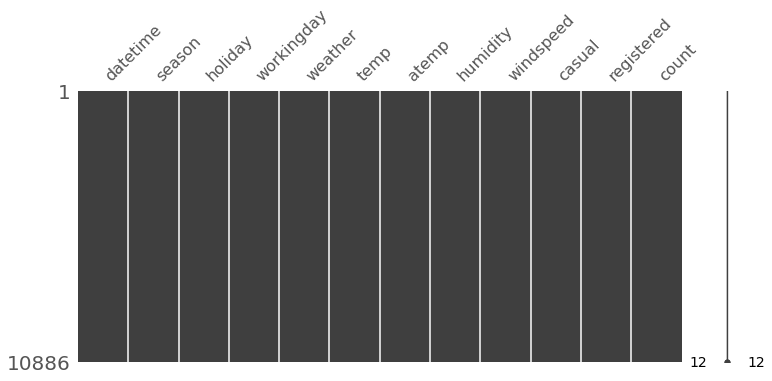
# datetime 년,달,일.. 초으로 나누기
train["year"] = train["datetime"].dt.year
train["month"] = train["datetime"].dt.month
train["day"] = train["datetime"].dt.day
train["hour"] = train["datetime"].dt.hour
train["minute"] = train["datetime"].dt.minute
train["second"] = train["datetime"].dt.second
train.shape
(10886, 18)
train.head()
| datetime | season | holiday | workingday | weather | temp | atemp | humidity | windspeed | casual | registered | count | year | month | day | hour | minute | second | |
|---|---|---|---|---|---|---|---|---|---|---|---|---|---|---|---|---|---|---|
| 0 | 2011-01-01 00:00:00 | 1 | 0 | 0 | 1 | 9.84 | 14.395 | 81 | 0.0 | 3 | 13 | 16 | 2011 | 1 | 1 | 0 | 0 | 0 |
| 1 | 2011-01-01 01:00:00 | 1 | 0 | 0 | 1 | 9.02 | 13.635 | 80 | 0.0 | 8 | 32 | 40 | 2011 | 1 | 1 | 1 | 0 | 0 |
| 2 | 2011-01-01 02:00:00 | 1 | 0 | 0 | 1 | 9.02 | 13.635 | 80 | 0.0 | 5 | 27 | 32 | 2011 | 1 | 1 | 2 | 0 | 0 |
| 3 | 2011-01-01 03:00:00 | 1 | 0 | 0 | 1 | 9.84 | 14.395 | 75 | 0.0 | 3 | 10 | 13 | 2011 | 1 | 1 | 3 | 0 | 0 |
| 4 | 2011-01-01 04:00:00 | 1 | 0 | 0 | 1 | 9.84 | 14.395 | 75 | 0.0 | 0 | 1 | 1 | 2011 | 1 | 1 | 4 | 0 | 0 |
plt.rc('font', family='Malgun Gothic') #글자 깨짐 방지
figure, ((ax1,ax2,ax3), (ax4,ax5,ax6)) = plt.subplots(nrows=2, ncols=3) # 다양한 그래프를 보고 싶다면 subplots 사용함
figure.set_size_inches(18,8)
sns.barplot(data=train, x="year", y="count", ax=ax1)
sns.barplot(data=train, x="month", y="count", ax=ax2)
sns.barplot(data=train, x="day", y="count", ax=ax3)
sns.barplot(data=train, x="hour", y="count", ax=ax4)
sns.barplot(data=train, x="minute", y="count", ax=ax5)
sns.barplot(data=train, x="second", y="count", ax=ax6)
ax1.set(ylabel='Count',title="연도별 대여량")
ax2.set(xlabel='month',title="월별 대여량")
ax3.set(xlabel='day', title="일별 대여량")
ax4.set(xlabel='hour', title="시간별 대여량")
[Text(0.5, 0, 'hour'), Text(0.5, 1.0, '시간별 대여량')]
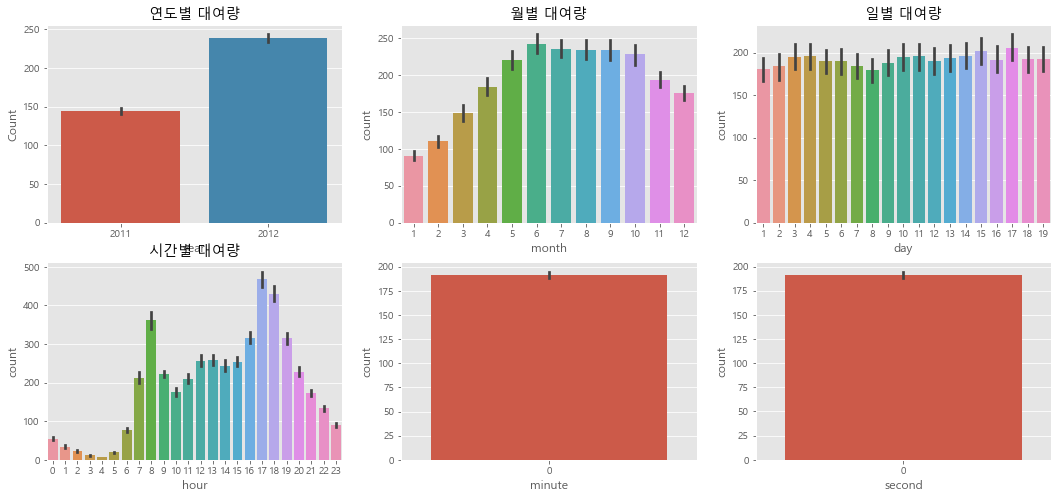
연도별 대여량은 2011년 보다 2012년이 더 많다.
월별 대여량은 6월에 가장 많고 7~10월도 대여량이 많다. 그리고 1월에 가장 적다.
일별대여량은 1일부터 19일까지만 있고 나머지 날짜는 test.csv에 있다. 그래서 이 데이터는 피처로 사용하면 안 된다.
시간 대 대여량을 보면 출퇴근 시간에 대여량이 많은 것 같다. 하지만 주말과 나누어 볼 필요가 있을 것 같다.
분, 초도 다 0이기 때문에 의미가 없다.
fig, axes = plt.subplots(nrows=2,ncols=2)
fig.set_size_inches(12, 10)
sns.boxplot(data=train,y="count",orient="v",ax=axes[0][0])
sns.boxplot(data=train,y="count",x="season",orient="v",ax=axes[0][1])
sns.boxplot(data=train,y="count",x="hour",orient="v",ax=axes[1][0])
sns.boxplot(data=train,y="count",x="workingday",orient="v",ax=axes[1][1])
axes[0][0].set(ylabel='Count',title="대여량")
axes[0][1].set(xlabel='Season', ylabel='Count',title="계절별 대여량")
axes[1][0].set(xlabel='Hour Of The Day', ylabel='Count',title="시간별 대여량")
axes[1][1].set(xlabel='Working Day', ylabel='Count',title="근무일 여부에 따른 대여량")
[Text(0.5, 0, 'Working Day'),
Text(0, 0.5, 'Count'),
Text(0.5, 1.0, '근무일 여부에 따른 대여량')]
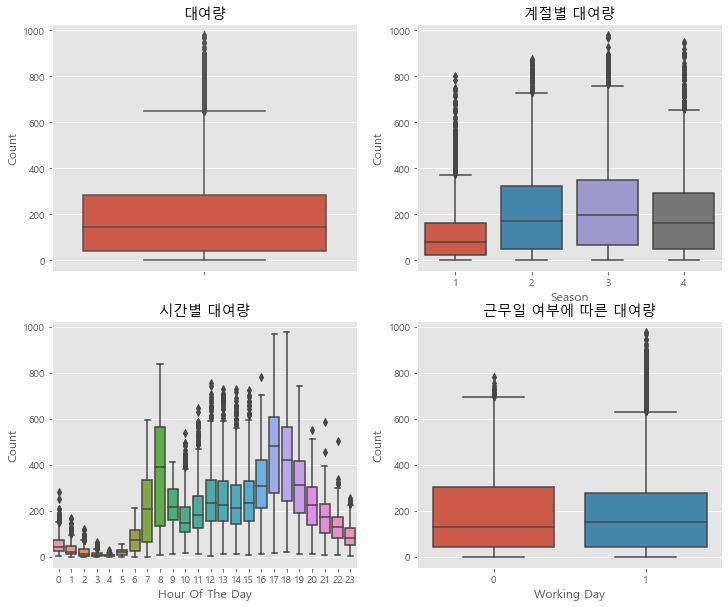
train["dayofweek"] = train["datetime"].dt.dayofweek #https://zephyrus1111.tistory.com/69 참고
train.shape #월,화,수....,일 로 요일컬럼생성
(10886, 19)
train["dayofweek"].value_counts()
5 1584
6 1579
3 1553
2 1551
0 1551
1 1539
4 1529
Name: dayofweek, dtype: int64
fig,(ax1,ax2,ax3,ax4,ax5)= plt.subplots(nrows=5)
fig.set_size_inches(18,25)
sns.pointplot(data=train, x="hour", y="count", ax=ax1)
sns.pointplot(data=train, x="hour", y="count", hue="workingday", ax=ax2)
sns.pointplot(data=train, x="hour", y="count", hue="dayofweek", ax=ax3)
sns.pointplot(data=train, x="hour", y="count", hue="weather", ax=ax4)
sns.pointplot(data=train, x="hour", y="count", hue="season", ax=ax5)
<AxesSubplot:xlabel='hour', ylabel='count'>
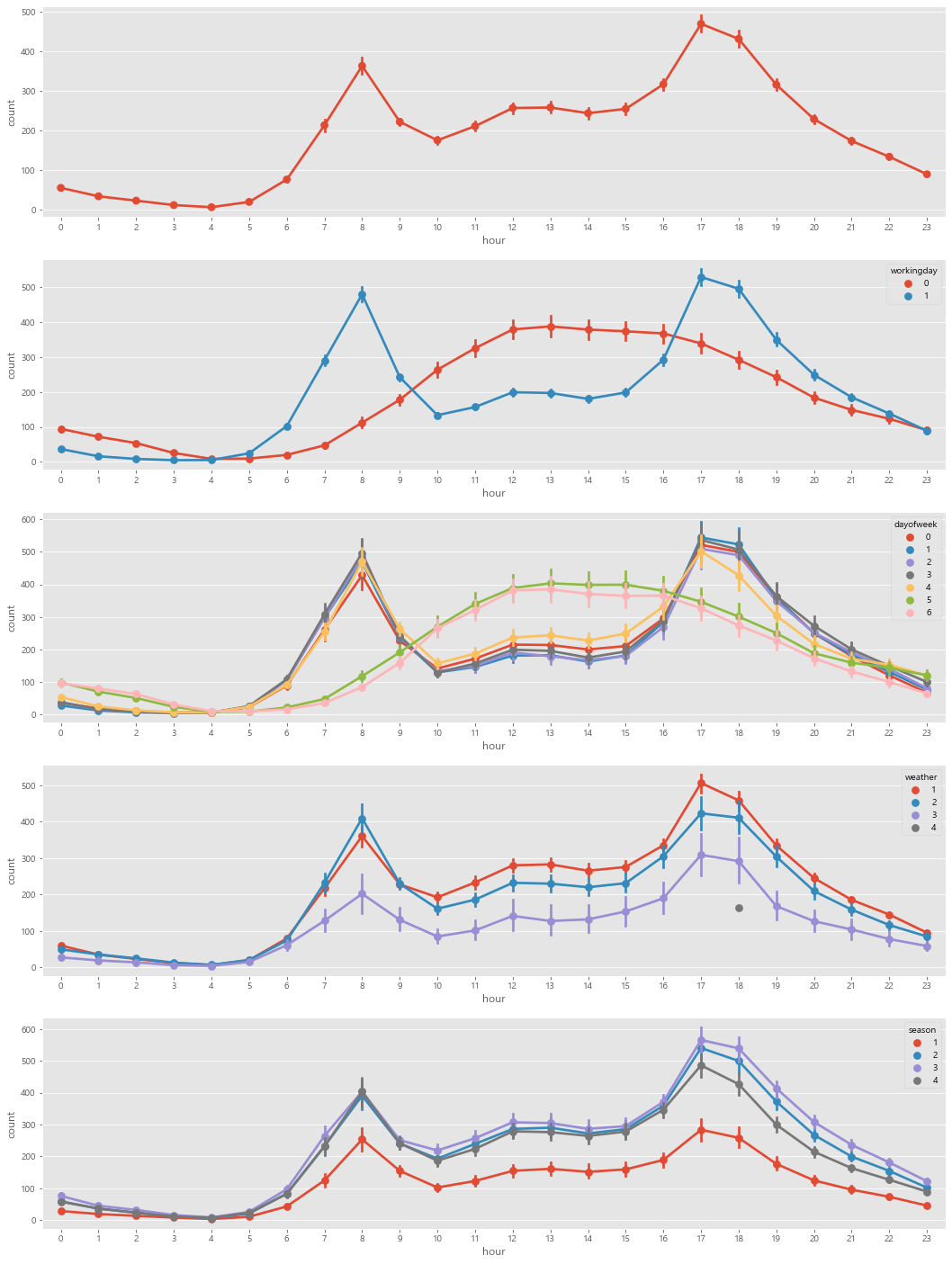
- season : 봄,여름,가을,겨울 순 / 가을에 가장 많이 자전거를 빌린다
- 출,퇴근 시간에 자전거를 많이 빌린다.
corrMatt = train[["temp", "atemp", "casual", "registered", "humidity", "windspeed", "count"]]
corrMatt = corrMatt.corr()
print(corrMatt)
mask = np.array(corrMatt)
mask[np.tril_indices_from(mask)] = False
temp atemp casual registered humidity windspeed \
temp 1.000000 0.984948 0.467097 0.318571 -0.064949 -0.017852
atemp 0.984948 1.000000 0.462067 0.314635 -0.043536 -0.057473
casual 0.467097 0.462067 1.000000 0.497250 -0.348187 0.092276
registered 0.318571 0.314635 0.497250 1.000000 -0.265458 0.091052
humidity -0.064949 -0.043536 -0.348187 -0.265458 1.000000 -0.318607
windspeed -0.017852 -0.057473 0.092276 0.091052 -0.318607 1.000000
count 0.394454 0.389784 0.690414 0.970948 -0.317371 0.101369
count
temp 0.394454
atemp 0.389784
casual 0.690414
registered 0.970948
humidity -0.317371
windspeed 0.101369
count 1.000000
fig, ax = plt.subplots()
fig.set_size_inches(20,10)
sns.heatmap(corrMatt, mask=mask,vmax=.8, square=True,annot=True)
<AxesSubplot:>
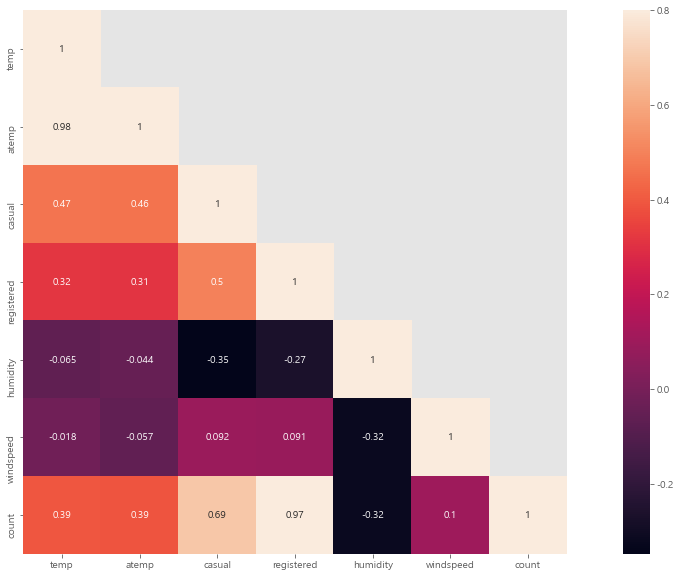
온도, 습도, 풍속은 거의 연관관계가 없다.
대여량과 가장 연관이 높은 건 registered 로 등록 된 대여자가 많지만, test 데이터에는 이 값이 없다.
atemp와 temp는 0.98로 상관관계가 높지만 온도와 체감온도로 피처로 사용하기에 적합하지 않을 수 있다.
fig,(ax1,ax2,ax3) = plt.subplots(ncols=3)
fig.set_size_inches(12, 5)
sns.regplot(x="temp", y="count", data=train,ax=ax1)
sns.regplot(x="windspeed", y="count", data=train,ax=ax2)
sns.regplot(x="humidity", y="count", data=train,ax=ax3)
<AxesSubplot:xlabel='humidity', ylabel='count'>
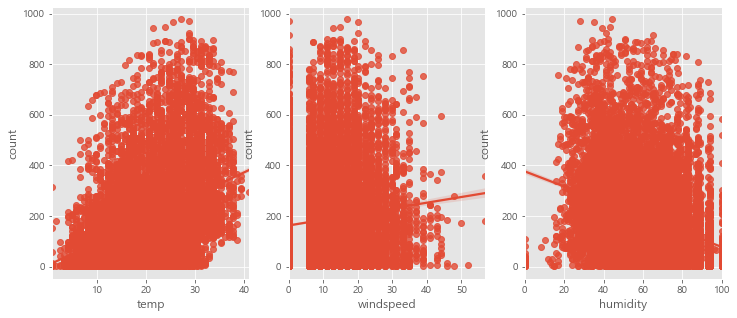
- 풍속의 경우 0에 숫자가 몰려 있는 것으로 보인다. 아마도 관측되지 않은 수치에 대해 0으로 기록된 것이 아닐까 추측해 본다.
def concatenate_year_month(datetime):
return "{0}-{1}".format(datetime.year, datetime.month)
train["year_month"] = train["datetime"].apply(concatenate_year_month)
print(train.shape)
train[["datetime", "year_month"]].head()
(10886, 20)
| datetime | year_month | |
|---|---|---|
| 0 | 2011-01-01 00:00:00 | 2011-1 |
| 1 | 2011-01-01 01:00:00 | 2011-1 |
| 2 | 2011-01-01 02:00:00 | 2011-1 |
| 3 | 2011-01-01 03:00:00 | 2011-1 |
| 4 | 2011-01-01 04:00:00 | 2011-1 |
train[["datetime", "year_month"]].tail()
| datetime | year_month | |
|---|---|---|
| 10881 | 2012-12-19 19:00:00 | 2012-12 |
| 10882 | 2012-12-19 20:00:00 | 2012-12 |
| 10883 | 2012-12-19 21:00:00 | 2012-12 |
| 10884 | 2012-12-19 22:00:00 | 2012-12 |
| 10885 | 2012-12-19 23:00:00 | 2012-12 |
fig, (ax1, ax2) = plt.subplots(nrows=1, ncols=2)
fig.set_size_inches(18, 4)
sns.barplot(data=train, x="year", y="count", ax=ax1)
sns.barplot(data=train, x="month", y="count", ax=ax2)
fig, ax3 = plt.subplots(nrows=1, ncols=1)
fig.set_size_inches(18, 4)
sns.barplot(data=train, x="year_month", y="count", ax=ax3)
<AxesSubplot:xlabel='year_month', ylabel='count'>


- 2011년보다 2012년의 대여량이 더 많다.
- 겨울보다는 여름에 대여량이 많다.
- 2011년과 2012년의 월별 데이터를 이어보면 전체적으로 증가하는 추세이다.
# trainWithoutOutliers
trainWithoutOutliers = train[np.abs(train["count"] - train["count"].mean()) <= (3*train["count"].std())]
print(train.shape)
print(trainWithoutOutliers.shape)
(10886, 20)
(10739, 20)
# count값의 데이터 분포도를 파악
figure, axes = plt.subplots(ncols=2, nrows=2)
figure.set_size_inches(12, 10)
sns.histplot(train["count"], ax=axes[0][0])
stats.probplot(train["count"], dist='norm', fit=True, plot=axes[0][1])
sns.histplot(np.log(trainWithoutOutliers["count"]), ax=axes[1][0])
stats.probplot(np.log1p(trainWithoutOutliers["count"]), dist='norm', fit=True, plot=axes[1][1])
((array([-3.82819677, -3.60401975, -3.48099008, ..., 3.48099008,
3.60401975, 3.82819677]),
array([0.69314718, 0.69314718, 0.69314718, ..., 6.5971457 , 6.59850903,
6.5998705 ])),
(1.3486990121229778, 4.562423868087808, 0.9581176780909619))
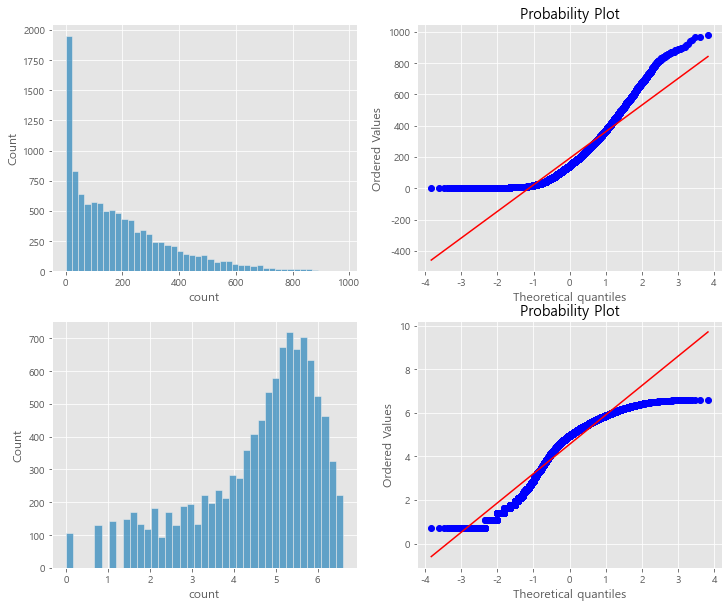
count변수가 오른쪽에 치우쳐져 있다. 대부분의 기계학습은 종속변수가 normal 이어야 하기에 정규분포를 갖는 것이 바람직하다. 대안으로 outlier data를 제거하고 “count”변수에 로그를 씌워 변경해 봐도 정규분포를 따르지는 않지만 이전 그래프보다는 좀 더 자세히 표현하고 있다.